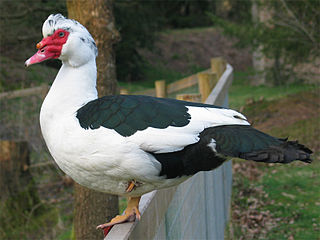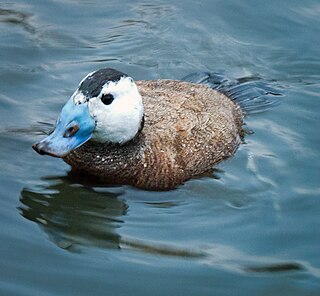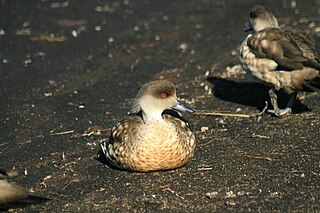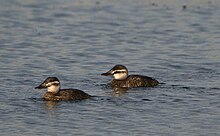
The Anatidae are the biological family of water birds that includes ducks, geese, and swans. The family has a cosmopolitan distribution, occurring on all the world's continents except Antarctica. These birds are adapted for swimming, floating on the water surface, and in some cases diving in at least shallow water. The family contains around 174 species in 43 genera.

The freckled duck is a waterfowl species endemic to Australia. The freckled duck has also been referred to as the monkey duck or oatmeal duck. These birds are usually present in mainland Australia, but disperse to coastal and subcostal wetlands in the dry period. During such times it is common for the freckled duck population to congregate in flocks in the same area, giving the impression that they are more common than they really are.

The mallard or wild duck is a dabbling duck that breeds throughout the temperate and subtropical Americas, Eurasia, and North Africa. It has been introduced to New Zealand, Australia, Peru, Brazil, Uruguay, Argentina, Chile, Colombia, the Falkland Islands, and South Africa. This duck belongs to the subfamily Anatinae of the waterfowl family Anatidae. Males have purple patches on their wings, while the females have mainly brown-speckled plumage. Both sexes have an area of white-bordered black or iridescent blue feathers called a speculum on their wings; males especially tend to have blue speculum feathers. The mallard is 50–65 cm (20–26 in) long, of which the body makes up around two-thirds the length. The wingspan is 81–98 cm (32–39 in) and the bill is 4.4 to 6.1 cm long. It is often slightly heavier than most other dabbling ducks, weighing 0.7–1.6 kg (1.5–3.5 lb). Mallards live in wetlands, eat water plants and small animals, and are social animals preferring to congregate in groups or flocks of varying sizes.

The ring-necked duck is a diving duck from North America commonly found in freshwater ponds and lakes. The scientific name is derived from Greek aithuia, an unidentified seabird mentioned by authors including Hesychius and Aristotle, and Latin collaris, "of the neck" from collum, "neck".

The musk duck is a highly aquatic, stiff-tailed duck native to southern Australia. It is the only living member of the genus Biziura. An extinct relative, the New Zealand musk duck or de Lautour's duck, once occurred on New Zealand, but is only known from prehistoric subfossil bones. It was about 8% longer than the living species, with a particularly large head.

The common goldeneye or simply goldeneye is a medium-sized sea duck of the genus Bucephala, the goldeneyes. Its closest relative is the similar Barrow's goldeneye. The genus name is derived from the Ancient Greek boukephalos, a reference to the bulbous head shape of the bufflehead. The species name is derived from the Latin clangere.

The ruddy duck is a duck from North America and one of the stiff-tailed ducks. The genus name is derived from Ancient Greek oxus, "sharp", and oura, "tail", and jamaicensis is "from Jamaica".

The Muscovy duck is a duck native to the Americas, from the Rio Grande Valley of Texas and Mexico south to Argentina and Uruguay. Feral Muscovy ducks are found in New Zealand, Australia, and in Central and Eastern Europe. Small wild and feral breeding populations have also established themselves in the United States, particularly in Florida, Louisiana, Massachusetts, the Big Island of Hawaii, as well as in many other parts of North America, including southern Canada.

The black-headed duck is a South American duck in subfamily Oxyurinae of family Anatidae. It is found in Argentina, Bolivia, Brazil, Chile, Paraguay, and Uruguay.

The white-headed duck is a small diving duck some 45 cm (18 in) long. The male has a white head with black crown, a blue bill, and reddish-grey plumage. The female has a dark bill and rather duller colouring. Its breeding habitat is lakes with open water and dense vegetation at the margin. It dives under water and feeds on aquatic vegetation as well as some animal matter. It is more likely to swim away from a perceived threat than to fly. This duck is known from Spain, North Africa, Western Asia and Central Asia. Populations are declining, mostly due to loss of habitat and pollution, and the International Union for Conservation of Nature has rated the bird's status as "endangered".

The mottled duck or mottled mallard is a medium-sized species of dabbling duck. It is intermediate in appearance between the female mallard and the American black duck. It is closely related to those species, and is sometimes erroneously considered a subspecies of the former.

The New Zealand scaup, also known as the black teal or pāpango in Māori, is a diving duck species of the genus Aythya endemic to New Zealand. They weigh around 650 grams (23 oz) and measure around 40 centimetres (16 in), and have dark-coloured plumage. They are found throughout New Zealand in deep natural and man-made lakes and ponds.

The crested duck or South American crested duck is a species of duck native to South America, belonging to the monotypic genus Lophonetta. It is sometimes included in Anas, but it belongs to a South American clade that diverged early in dabbling duck evolution. There are two subspecies: L. specularioides alticola and L. specularioides specularioides. The Patagonian crested duck is also called the southern crested duck and its range lies in the Falklands, Chile, and Argentina.

The masked duck is a tiny stiff-tailed duck ranging through the tropical Americas.

The Maccoa duck is a stiff-tailed diving duck found across Eastern and Southern Africa.

A penis is the primary sexual organ that male animals use to inseminate females during copulation. Such organs occur in many animals, both vertebrate and invertebrate, but males do not bear a penis in every animal species. Furthermore, penises are not necessarily homologous.

An erection is a physiological phenomenon in which the penis becomes firm, engorged, and enlarged. Penile erection is the result of a complex interaction of psychological, neural, vascular, and endocrine factors, and is often associated with sexual arousal or sexual attraction, although erections can also be spontaneous. The shape, angle, and direction of an erection vary considerably between humans.
An intromittent organ is any external organ of a male organism that is specialized to deliver sperm during copulation. Intromittent organs are found most often in terrestrial species, as most non-mammalian aquatic species fertilize their eggs externally, although there are exceptions. For many species in the animal kingdom, the male intromittent organ is a hallmark characteristic of internal fertilization.

The Andean duck is a bird species native to the Andean Mountains of South America, one of the stiff-tailed ducks. It was considered a subspecies of the ruddy duck. In fact, some taxonomic authorities still consider it conspecific, including the American Ornithological Society.

The eastern spot-billed duck or Chinese spot-billed duck is a species of dabbling duck that breeds in East and Southeast Asia. This species was formerly considered a subspecies of the Indian spot-billed duck and both were referred to as the spot-billed duck. The name is derived from the yellow spot on the bill.























